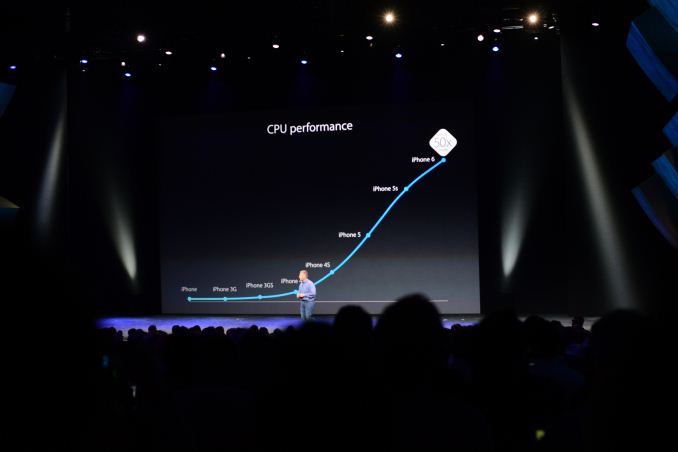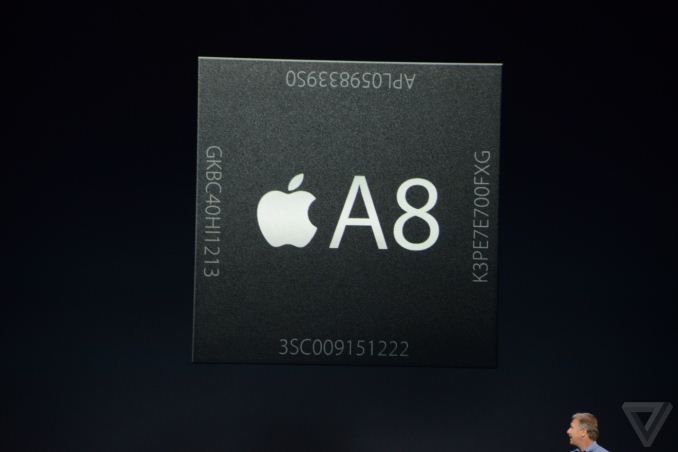Apple Announces A8 SoC
by Ryan Smith on September 9, 2014 1:45 PM EST
As expected from this year’s iPhone keynote, Apple has announced a new member of their internally developed family of ARM SoCs.
The latest SoC, dubbed A8, is Apple’s first SoC built on the 20nm process, and among the first SoCs overall to be built on this process. Apple notes that it has 2 billion transistors and is 13% smaller than the A7, which would give it upwards of twice as many transistors as the A7 and would put the die size at about 89mm2.

Image courtesy The Verge
From a performance perspective Apple is promising 25% faster CPU performance than A7. As is usually the case with Apple, they aren’t talking about the underlying CPU core – though this is a problem we’re working to rectify – so it remains to be seen how much of this is due to CPU architectural upgrades and how much is from clockspeed improvements afforded by the 20nm process. Apple just introduced their 64bit Cyclone core last year, so it stands to reason that just a year later and with the transition to 64bit already completed, A8 packs a CPU that is similar to Cyclone.
| Apple SoC Evolution | |||||
| CPU Perf | GPU Perf | Die Size | Transistors | Process | |
| A5 | ~13x | ~20x | 122m2 | <1B | 45nm |
| A6 | ~26x | ~34x | 97mm2 | <1B | 32nm |
| A7 | 40x | 56x | 102mm2 | >1B | 28nm |
| A8 | 50x | 84x | 89mm2 | ~2B | 20nm |
Meanwhile Apple is being even less specific about the GPU, but from their published baseline performance comparisons against the iPhone 1, the A8 is said to be 84x faster on graphics. This compares to a published figure of 56x for the A7, which implies that the A8’s GPU is 1.5x faster than the A7’s. Given Apple’s conservative stance on clockspeeds for power purposes and the die space gains from the 20nm process, it seems likely that Apple has upgraded from a 4 core PowerVR GPU to a 6 core PowerVR GPU, likely the flagship GX6650, which would account for the 50% performance gain right there.
Finally, Apple notes that the A8 is designed to be 50% more energy efficient than the A7. Some of these efficiency gains would come from gains due the 20nm process, however this large of a gain would indicate that Apple has done additional work at the architectural level to improve efficiency, as smaller manufacturing nodes alone do not see these kinds of gains.
Update: We have posted our initial A8 analysis here










66 Comments
View All Comments
Morawka - Tuesday, September 9, 2014 - link
intel's die size's are in orders of magnitude bigger than these arm cores, yet they can still a 4.5 watt chip. very impressive intel.melgross - Tuesday, September 9, 2014 - link
No, they're not. They are bigger, but not by orders of magnitude.mkozakewich - Tuesday, September 9, 2014 - link
100-1000 times would be... what? 89 to 890 cm^2. That would be 10-30 cm on each side of a square. 89 mm^2 would be just less than 1 cm on each side.A single order of magnitude larger would be 890mm^2, or 30 mm (3 cm) on one side. Hmm, sure. Intel's chips are one order of magnitude larger, then.
name99 - Tuesday, September 9, 2014 - link
They ARE orders of magnitude more expensive! Broadwell Y (the 4.5W part) costs $281.name99 - Tuesday, September 9, 2014 - link
The Broadwell Y thing you buy --- the little tiny PCB with the die on it --- is 500 mm^2.That's not exactly comparable, but is the relevant number in terms of space it will take up in the phone.
The number of transistors is 1.3B which sounds like less than A8 (is less than A8!) but remember that's for just the CPU and GPU, whereas for A8 it's also all the other stuff on the chip. It's probably reasonable to peg Broadwell Y at something like 50% more transistors than the equivalent parts of the A8. a
tipoo - Tuesday, September 9, 2014 - link
That's why I'm thinking they may cave in and add more cores, as going wider has limitations on performance gains, while raising clock speeds is undesirable for power draw.melgross - Tuesday, September 9, 2014 - link
25% CPU, 50% GPU. Their numbers.Kevin G - Tuesday, September 9, 2014 - link
Power consumption still takes precedence and more RAM takes more power. Then again, Apple has been aggressive with the L3 cache which enables the memory bus to enter a deep sleep state more often. One would think that that'd mitigate some of the power consumption issues with more memory. Perhaps it is the new iPads this year that will receive additional memory?I'm actually surprised that they didn't include SMT in this iteration. I can see this being a win in several low power scenarios outside of just performance. (Why wake up the second core when you have SMT during communication bursts?)
Going with the power consumption theme, I don't see Apple going quad in the iPhone 6S. Rather I see either SMT and/or a triple core design. It also wouldn't surprise me to see an A9X chip for iPads if/when this happens. Having the iPad go quad core makes more sense than in a phone.
tipoo - Wednesday, September 10, 2014 - link
Refreshing tabs and apps would also take power, the CPU would have to stay awake longer, and NAND would have to be accessed. I wonder if that extra GB of RAM would really take more power than it would save.megakilo - Tuesday, September 9, 2014 - link
So this is pretty much a tick. Shrink the die to save power + cost and also bump up freq a little bit.